
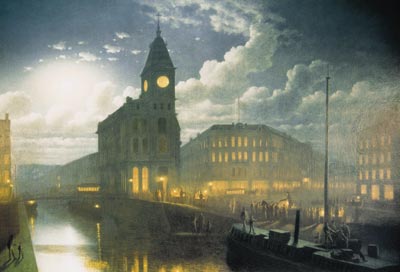
The moon is waxing toward her full and every heart beats for joy at the noble scene.
How pleasant too, to see the brilliant lamps of numberless boats passing and repassing upon the
smooth unruffled surface of the Canal, to hear the song of the jolly boatman or driver-boy, to see
the boats sweeping by freighted with the riches of the West.
-- Jonathan Pearson, Diary, July 25, 1833
When twenty-year-old Jonathan Pearson took his summer trip on the Erie Canal in 1833, he joined the many thousands of people who were taking advantage of the new inland waterway and its faster, smoother mode of travel. The sights and sounds of journeys on the Erie Canal during its heyday in the nineteenth century can be rediscovered in the words and images recorded by travelers and artists who experienced the canal firsthand.
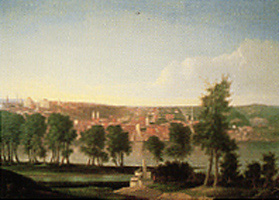
The opening of the Erie Canal in 1825 enabled waves of travelers from America and Europe to visit places to the west that had been previously inaccessible. Many of these travelers wrote about their experiences and impressions in private journals or travelogues that were then published. They chronicled a wide range of canal experiences, from the picturesque to the mundane. Few could resist commenting on the passage through the dramatic narrow channel approaching Little Falls:
The crages (sic) here are stupendous - irregular and massive piles of rock, from which springs the lofty pine and cedar, are heaped in frightful disorder on each other, and give the scene a terrifically grand appearance. (Simon A. O'Ferrall, 1832)
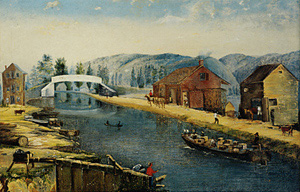
Similarly, many were impressed by the great noise, activity, and rapid growth of the many canal towns along the way:
"Rochester. The site of this flourishing city of 12,000 souls was in 1812 a field of stumps! Now it's as matter-of-fact a town as the union contains, with full compliment (sic) of churches, markets, inns, mills, banks, and bustling mortals." (David Wilkie, 1837)
The sometimes less than charming aspects of life on the canal were also duly noted:
"On the canal there is no Sabbath. I must say that I never witnessed so much immorality and vice, profanity and drinking in the same length of time before in my life .... Canal men are ... as a whole ... a coarse and untaught set of vagabonds whose chief delight is to carouse and fight." (Jonathan Pearson, Diary, August 11, 1833)
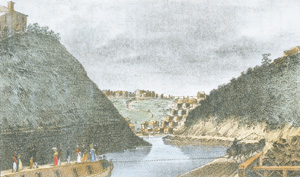
The first visual representations of the canal came from prints published in travel guides and magazines beginning immediately after the canal opened in 1825. Basil Hall, a British naval officer and world traveler who published the travelogue Travels in North America in the Years 1827 and 1828, also published a book of prints from sketches he drew with his camera lucida while traveling, called Forty Etchings from Sketches Made with the Camera Lucida in North America in 1827 and 1828. Popular magazines like Harper's Weekly and Frank Leslie's Illustrated Newspaper also ran stories and printed canal images throughout the nineteenth century.
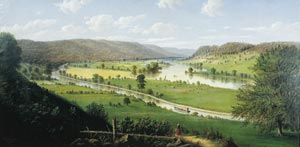
Prints were quickly followed by paintings, as artists who traveled on the Erie returned to their studios to develop sketches into larger works. Some artists portrayed the canal with close fidelity, others chose to romanticize it.
And while many artists, like their literary counterparts, chose to evoke the most sublime and awe-inspiring features of the 363-mile waterway, all aspects of the canal experience were recorded visually, from the crowded packet boats and canal-side stores of Edward Lamson Henry's Before the Days of Rapid Transit (c.1900) and On the Canal (c.1890), to the bustling activity of towns and cities in Thomas Evershed's View Showing the Progress on the Lock Section, Lockport (1839) or Johan Culverhouse's Clinton Square, Syracuse (1872).
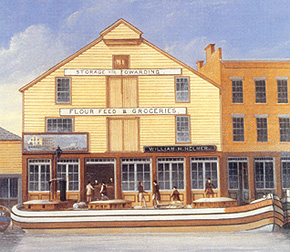
Though prints and paintings were the most popular forms for Erie Canal imagery, its name and image were also evoked in more unusual ways. Popular canal scenes were reproduced on plates, cups, and bowls; medals were cast to celebrate the opening of the canal; canal scenes were block-printed on wallpaper; a vest with the words "DeWitt Clinton and the Grand Canal" covering its silk front was produced; and a scene of a boat on a canal aqueduct over a raging river was carved into the gravestone of canal contractor Luke Hitchcock.
During the nineteenth century, the Erie Canal captured the imagination of Americans and Europeans alike. A source of wonder and inspiration for the artists and travelers who made their way along its waters, the canal generated an abundance and variety of art and literature. The paintings, prints, maps and travelers' descriptions presented here lead the viewer on a trip through the Erie Canal as it is reflected in the art of the period and in the voices of those who left a written account of their journeys.
http://www.eriecanal.org/UnionCollege/Recollections_and_Reflections.html